
Pinhoe
Page updated 20 March 2009
 Once the archetypal Devon
village, with
thatched cottages and cosy pubs, Pinhoe has become a semi-detached
suburb of
Exeter, cut in two by a busy road, and astride a railway line. However,
a
short walk from the centre, and away from the trading estate, you will
be taken back in time to the Devon lanes that used to be.
Once the archetypal Devon
village, with
thatched cottages and cosy pubs, Pinhoe has become a semi-detached
suburb of
Exeter, cut in two by a busy road, and astride a railway line. However,
a
short walk from the centre, and away from the trading estate, you will
be taken back in time to the Devon lanes that used to be.
There have been many variations of the name Pinhoe over the years, with the Anglo Saxon Peonha, Pinnoc, and Pinnoch, the Domesday Pinoe and the later Pinho, Pynnoe, and Pinhowe all vying for attention at one time or other. The probably meaning is from the Celtic Pen and Saxon Hoe, meaning the top of the hill.
It is thought that the first church to be built in Pinhoe, and a good place to start this history, was in 926. It was a wood and wattle affair, with a presiding chaplain provided by the minster of St Peter, Exeter. In 1001, invading Danes beat the Saxon King Ethelred's army in a major battle at Pinhoe, near the present church. A local myth says that during the battle, the defending Saxons were running out of arrows, so the priest, riding a donkey, slipped through the Danish lines to Exeter to obtain some replenishments. He successfully returned to Pinhoe with his precious arrows, to no avail as the Danes eventually won the day, after a great slaughter had taken place. The priest survived, and was rewarded for his efforts with an annual payment of 1 mark, from the King, a payment that is still paid to the vicar every October, although now worth 80 pence.
Domesday ascribes Pinhoe with 100 acres of wood, 100 acres of pasture and 20 acres of meadow. The land had belonged to Edward the Confessor before the Conquest, and would have been part of the vast Royal Manor of Wonford, that surrounded Exeter.
The Church was the heart
The present church is situated in the hills, north of the village, away
from the floodplain below. It is certain that the church existed after
the Norman invasion, for William gave
Pinhoe Church to the monks of Battle Abbey, whose successors
transferred it to St Nicholas Priory, itself having also been founded
by the Abbey. Dedicated to St Michael, the monks rebuilt the church
in the early 15th century in a perpendicular style, which largely
remains to this day. At the dissolution of the monasteries, it passed
to the Dean and Chapter of Exeter. It was not on the edge of its
farming community but the heart.
The Manor remained under the King until Henry III, when it passed to Robert de Vallibus of Gillesland around about 1236. It passed through marriage to Sir Thomas de Molton and then Sir William Cheyney. Cheyney's grandson was childless so in 1530, the Manor was divided and sold soon after.
The Nineteenth Century
John Land, who built the New London
Inn,
became the
wealthiest landlord in the west country, and the oldest, when he died,
age 87 on 24 January 1817. The streets of Exeter were lined with people
for his funeral cortege to Pinhoe. He is buried in the aisle of the
church, along with his wife. Land left £200 to be invested, and
the interest to be used for the poor of the parish at Christmas.
Skirting the hills, down on the floodplain, Main Road or the old Bath Road, bisects the present village. Photographs from the turn of the twentieth century show a narrow, cottage lined, dirt road that up until the coming of the railway was an important coaching route and turnpike to Bath. The railway age reached Pinhoe in 1861 when the London and South Western line from Waterloo passed south of the village to reach Exeter at Queen Street Station. Pinhoe benefited with its own railway station, complete with a booking hall and ladies' and general waiting rooms. The nearby Pinhoe Brick Works was served by its own siding from 1882.
Villagers relied on the railway for trips into Exeter, and in 1906 a Rail Motor Car Service was introduced. The coming of the combustion engine brought 'Cross Col's' bus service, through the village between Cullompton and Exeter.
Schools
It was in the nineteenth century that many small communities opened
their first school. In 1837, a schoolroom was built on the site of
Church House, which offered the children of Pinhoe, when they were not
required in the fields, an education of a sort. In 1850 a National
School opened in 2 cottages, which could cope with more children until
it too closed in 1887 and was converted into the Mission Church.
The year before the National School closed the Pinhoe Church of England School was constructed on land purchased from Lord Poltimore. The children from the National School transferred in 1887 when the new school opened. By 1905 it as becoming too small for the 189 children, so it was enlarged and the first headmaster appointed.
Moving on to 1954, and a new Infant School was
constructed in Harrington Lane, followed in 1975 by a Middle
School; the old Church of England School was demolished in 1977.
The First
War
When the German army swept across the Low Countries into France, in
August 1914, a quarter of a million Belgian civilians escaped to
England, requiring communities all over the country to take in these
refugees. The Pinhoe and Poltimore Cottage Garden Society cancelled
their annual flower show during the war and worked to maintain three
houses for the refugees. Pinhoe raised £382, and donated toys,
bedding and other household items, over the four years for the rent and
furnishings for the three houses.
The men of the village rallied around the flag and out of a population of just over a thousand, 188 joined the armed forces while 25 joined the volunteers. By November 1918, 25 had died for their country, winning a Victoria Cross, two Distinguished Service Orders, two Military Medals and a DCM.
The War Memorial, consisting of a 5 metre granite cross, was unveiled on the 15 November 1920 by Lt Col. Hext.
Fire and Flood
Like many communities, Pinhoe has had to endure fire and flood, and in
1703, a hurricane wrecked the vicarage, but it is twentieth century
disasters which still haunt the collective memory.
Probably the most dramatic, but mercifully injury free, fire in the
village's history occurred on 16 September 1925 when six cottages were
destroyed and 25 made homeless. This was a time when insurance was not
available to many, and the village had to rally round to help the
victims. A
spark from a passing traction engine alighted on a thatched roof. The
fire was discovered by a bus driver who called P C Holman, who tried
along with two RAC personnel to put out the
flames. They worked to remove as much furniture as possible as it
was obvious that the could not prevent the blaze spreading.
When the fire service arrived from Exeter, three lengths of hose
were
played out, but the pressure of the water was inadequate. A high wind
fanned the flames so that the thatch from the last cottage had to be
pulled off to try and save the building below. The fire service had to
play water on some cottages on the opposite side of the road to prevent
their ignition. Four thatched roof
cottages and two of slate were consumed by the flames, causing a loss
of £1,500.
Almost eight years later a flood in June 1933 caused by two sudden cloudbursts. In a little under three hours, cottages in Harrington Lane were engulfed by floodwater entering through the windows. Houses elsewhere in the village and along Main Road were also flooded, and some damaged by lightning strikes. Sleepers from the coalyard were washed down the line and the railway crossing gates were jammed by boulders and debris.
The May 1942 bombing
Pinhoe had its share of evacuees from the big cities at the outbreak of
the Second War in September 1939. They, and the many Americans waiting
for D-Day were a constant reminder of hostilities elsewhere.
The distance of Pinhoe from Exeter meant that the village was more of an observer of the blitz, rather than a target. However, a stray bomb did drop close to the church on 4 May 1942, damaging the windows. The vicar had already taken steps to protect church valuables and the old registers by burying them in a chamber, near by.
After the war, the village became the recipient of a gift from the people of America to thank Devon for the hospitality given to the many GI's who were billeted across the county. America Hall was the result of this generosity. It was constructed on 2 acres of land at Sunnylands in 1952.
The Pinhoe Road towards Exeter is now lined with trading estates retail units including Sainsburys, while St Lukes School has moved from Ringswell Avenue in Heavitree to a new site in Pinhoe at Harts Lane. The £4 million Monkerton link road between the Pinhoe Road and Ambassador Drive and the Sowton Industrial Estate has reduced traffic congestion in Pinhoe Road between the village and the city.
From a small, sleepy Devon village, Pinhoe has expanded into a popular dormitory for Exeter and a dynamic centre for business in its own right.
Sources: Pinhoe by Kathleen Woodley, Pinhoe of Yesteryear 1 and 2 by Chips Barber and the Express and Echo
 Pinhoe
Church.
Pinhoe
Church.
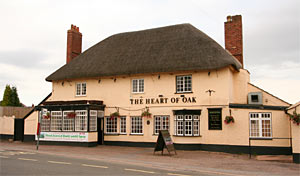 The Heart of Oak.
The Heart of Oak.
Heart of
Oak - this pub was
originally a coaching house. It was first
listed in a trade directory in 1889. The property, along with a meadow,
was sold in June 1892 for the sum of £600. It was described as a 'Good Roadside Public House with Stabling,
Outhouses, Garden and 3 Cottages.' In 1986 the Sun offered the
lease of the pub as a prize in a competition. It was renamed, A Place in the Sun and careful publicity shots made it seem like a quiet, rose covered
pub, hiding the busy road out front. Alex 'Hurricane' Higgins, Eric
Bristow the darts player, and several page 3 girls including Linda
Lusardi visited to generate even more publicity. A rival newspaper
endeavoured to put the record straight by referring to a paint peeling local. The lucky
winner turned down the lease and opted for a cash prize.
Poltimore Arms - this pub
may have originally been named the
Ship Inn, while it was previously the Bampfylde Arms. The key to the
Tollhouse, close by, was kept in the Poltimore Arms, in the days when
Main Road and Pinn Hill were part of the turnpike system. The earliest
listing in a trade directory was 1878.
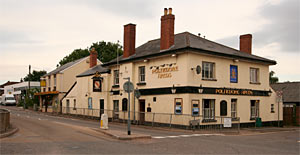 The Poltimore Arms.
The Poltimore Arms.
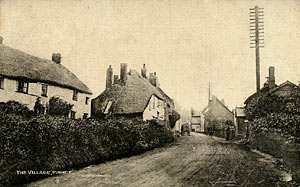 Pinhoe Village before the First War.
Pinhoe Village before the First War.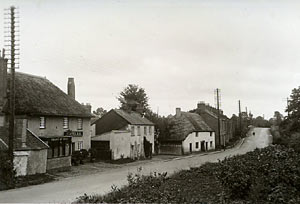 The Heart of Oak on the left in Main Road during the 1930s.
The Heart of Oak on the left in Main Road during the 1930s.
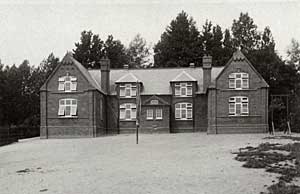 Pinhoe
School.
Pinhoe
School.
│ Top of Page │